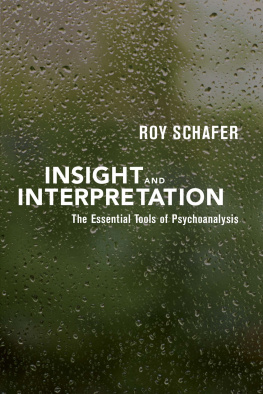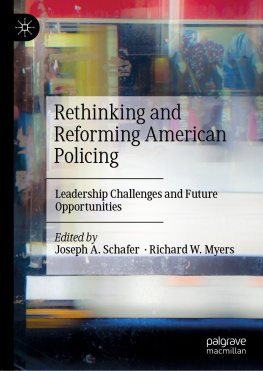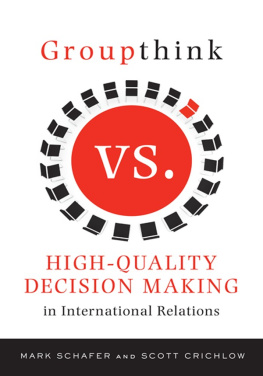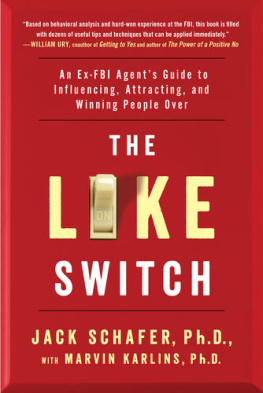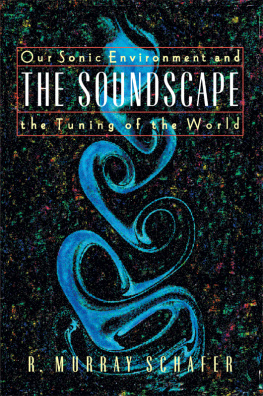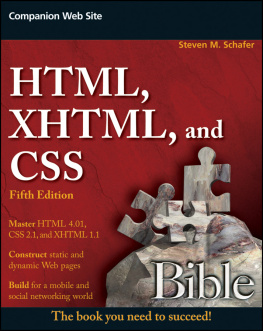Roy Schafer - Insight and Interpretation
Here you can read online Roy Schafer - Insight and Interpretation full text of the book (entire story) in english for free. Download pdf and epub, get meaning, cover and reviews about this ebook. year: 2020, publisher: Other Press, genre: Religion. Description of the work, (preface) as well as reviews are available. Best literature library LitArk.com created for fans of good reading and offers a wide selection of genres:
Romance novel
Science fiction
Adventure
Detective
Science
History
Home and family
Prose
Art
Politics
Computer
Non-fiction
Religion
Business
Children
Humor
Choose a favorite category and find really read worthwhile books. Enjoy immersion in the world of imagination, feel the emotions of the characters or learn something new for yourself, make an fascinating discovery.
- Book:Insight and Interpretation
- Author:
- Publisher:Other Press
- Genre:
- Year:2020
- Rating:3 / 5
- Favourites:Add to favourites
- Your mark:
- 60
- 1
- 2
- 3
- 4
- 5
Insight and Interpretation: summary, description and annotation
We offer to read an annotation, description, summary or preface (depends on what the author of the book "Insight and Interpretation" wrote himself). If you haven't found the necessary information about the book — write in the comments, we will try to find it.
Insight and Interpretation — read online for free the complete book (whole text) full work
Below is the text of the book, divided by pages. System saving the place of the last page read, allows you to conveniently read the book "Insight and Interpretation" online for free, without having to search again every time where you left off. Put a bookmark, and you can go to the page where you finished reading at any time.
Font size:
Interval:
Bookmark:
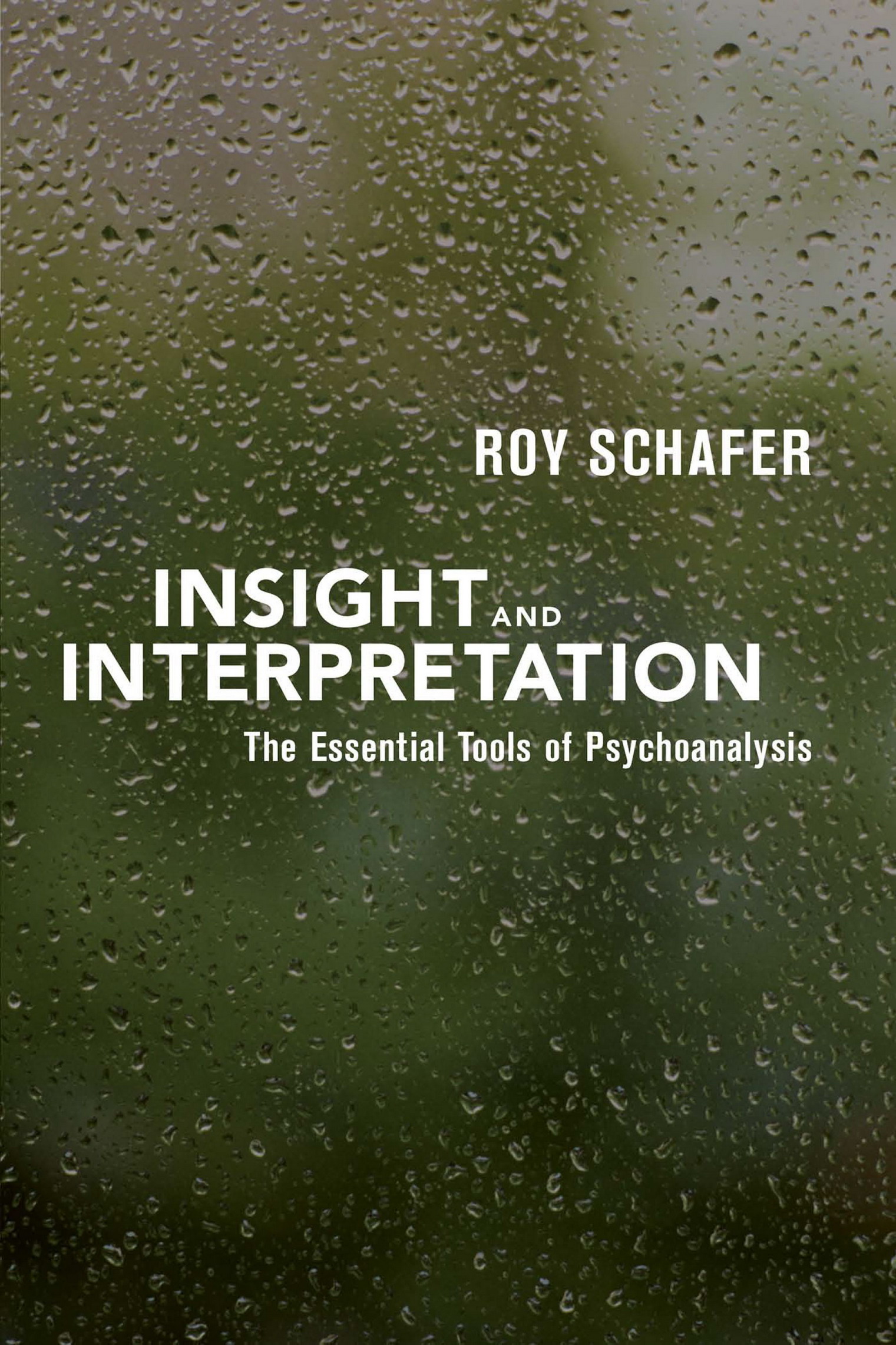
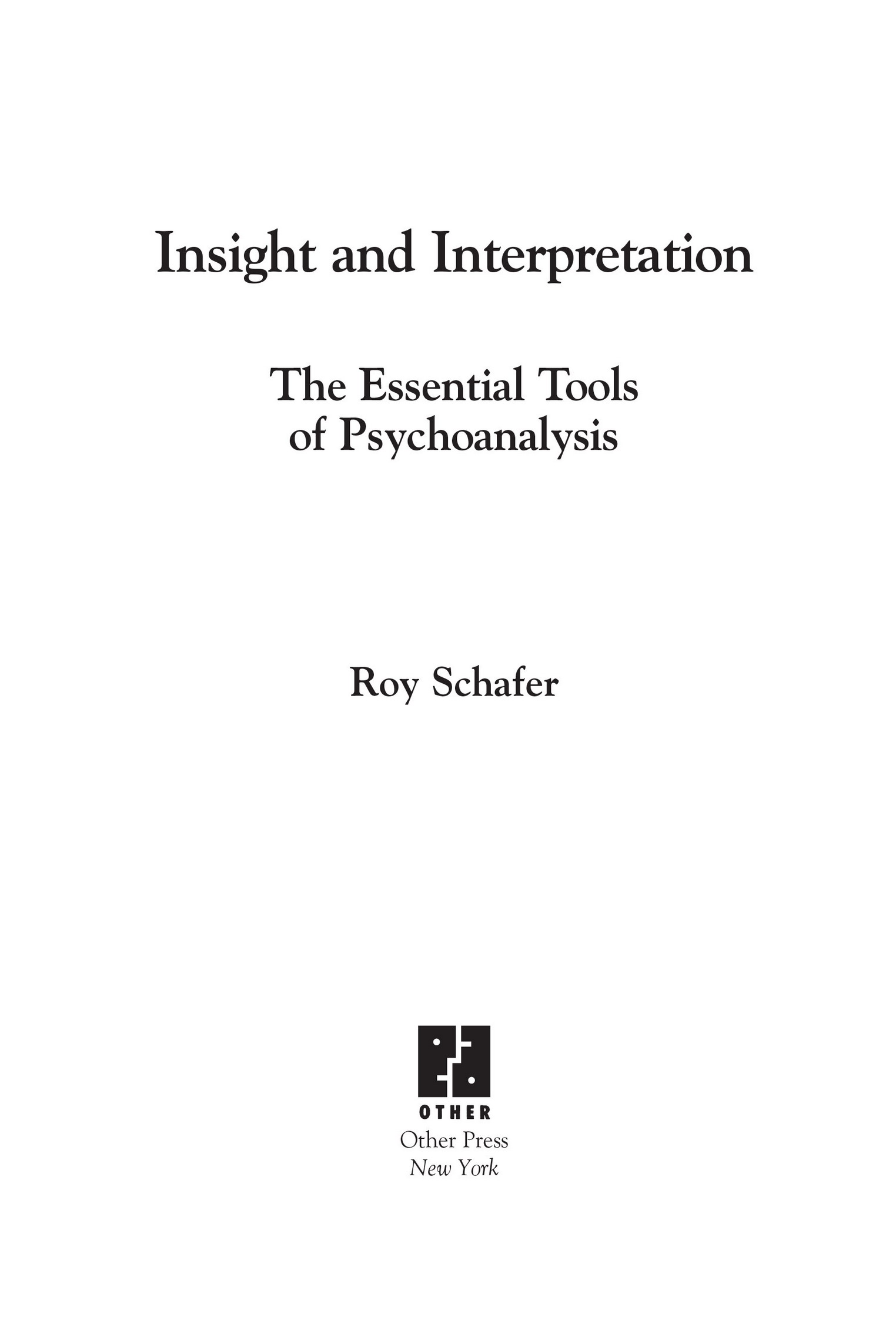
The author gratefully acknowledges the following publishers for their kind permission to reprint as chapters of this book the articles listed below:
Chapter 4 was originally published in The International Journal of Psycho-Analysis, vol. 78, under the title Vicissitudes of Remembering in the Countertransference. Copyright by The Institute of Psycho-Analysis, London, 1997.
Chapter 6 was originally published in Psychoanalytic Psychology, vol. 46. Copyright by The American Psychological Association, Washington, DC, 1999.
Chapter 7 was originally published in The Annual of Psychoanalysis, vol. 30, under the title On Male Nonnormative Sexuality and Perversion in Psychoanalytic Discourse. Copyright by The Analytic Press, Hillsdale, NJ, 2002.
Chapter 8 was originally published in Studies in Gender and Sexuality, vol. 2. Copyright by The Analytic Press, Hillsdale, NJ, 2001.
Copyright 2003 Roy Schafer
Production Editor: Robert D. Hack
First softcover printing 2008.
Ebook ISBN9781635421330
All rights reserved, including the right to reproduce this book, or parts thereof, in any form, without written permission from Other Press LLC, except in the case of brief quotations in reviews for inclusion in a magazine, newspaper, or broadcast. For information write to Other Press LLC, 267 Fifth Avenue, 6th Floor, New York, NY 10016. Or visit our Web site: www.otherpress.com.
The Library of Congress has cataloged the printed edition as follows:
Schafer, Roy.
Insight and interpretation : the essential tools of psychoanalysis / Roy Schafer.
p. cm.
Includes bibliographical references and index.
ISBN 978-1-59051-321-7 (alk. paper)
1. Psychoanalysis. 2. Sex (Psychology) 3. PsychotherapyPhilosophy. 4. Freud, Sigmund, 18561939. I. Title.
BF173 .S3277 2003
150.195dc21
2003007776
a_prh_5.6.0_c0_r0
I dedicate this book to those brilliant, creative, and daring faculty members of the Psychology Department of The City College of New YorkGardner Murphy, Max Hertzman, Isidore Chein, Joseph Barmack, and Martin Scheererwho, during my undergraduate years, so long ago, inspired me, as they did many other psych majors, to devote my career to the theory and clinical applications of psychoanalytic psychology.
Once again, I thank particularly my wife, Dr. Rita V. Frankiel, and my friend and colleague, Dr. William I. Grossman, for their continuing generous encouragement and their critical suggestions; they have been an invaluable source of help in getting on with the work reported here. I also acknowledge the steady assistance of Victoria Wright in preparing the manuscript copy and the consistently helpful role of my editors at Other Press, Stacy Hague and Bob Hack.
Again, a special thanks to Lanileigh Ting for her help.
I regard this book as a continuation of my efforts to supplement the invaluable contributions to the lives of human beings initiated by Freud and carried forward by generations of dedicated psychoanalysts after him, and I submit it to my readers with the hope that their participation in this tradition will benefit from my further reflections, proposals, and reports of clinical work.
The essays that follow cluster around what I consider to be the central themes of my writings on clinical, theoretical, and applied psychoanalysis: insight and interpretation. No aspect of insight and interpretation is given. Analytic material is complex, and inferences from it are often uncertain. Psychoanalysis is a process of construing meaning and constructing influential ways of telling it to others. In the instance of analysands, these are others who are ambivalent both about being understood in ways that makes them conscious of what they have repudiated and about acting on this understanding to undertake change. In each case, analysts learn as they go along what each analysand can hear and use creatively for adaptive purposes. Analysts are also obligated to do what they can to meet the standard of accomplishing their task impartially, that is, in a manner that is not dominated by their own conflicts and values but rather regulated by the systematic analytic approach to which they have committed themselves and the meanings that that approach leads them to infer and interpret.
Therefore, considered in its entirety, clinical analytic listening is not what might be called natural or commonsense listening, though it does partake of that, too. No form of listening warrants the simple designation natural, for while it might seem and feel entirely atheoretical and based on self-evident truths, it is never free from the influence of unformulated methods of making sense, each with theoretical implications of its own and all of it dominated by a jumble of preconceptions and values. Put a number of natural listeners together, and each of them will hear things in a more or less different way. In court, apparently unbiased witnesses dont tell the same story.
In Part I, Insights and Its Vicissitudes, I take up conceptual and technical problems that analysts encounter as they try to understand and communicate with their analysands and colleagues; these problems center on how to select, organize, retain, recall, and retell their analytic understanding of the material on which they have been working. Many colleagues with whom the analyst is communicating are likely to be more or less differently oriented theoretically or, even within the same school of thought, somewhat differently oriented clinically, and so they are likely to respond ambivalently, if not dismissively, to the insights being formulated. For example, in recent years much controversy has developed over the question of how to conceptualize the interaction of the two participants in the analytic process. It is now generally agreed that, inevitably, personal factors influence the analysts point of view on what is encountered or evoked as well as what should be encountered or evoked, such as certain specific manifestations of sex and aggression in the transference. However, many of the propositions concerning countertransference and intersubjectivity that have been put forward in this connection have been based on incompatible theoretical systems and technical approaches. Among other things, these variations feature somewhat different ideas of objectivity, evidence, and truth. As a result, the possibility of productive debate is severely limited. Therefore, it should occasion no surprise that, as yet, no consensus has been reached. Debate continues as to the nature, extent, and weight to be given to the influence that personal issues specific to the analyst exert on the analytic process. Also continuously debated is how best to deal with that influence, a case in point being arguments that are advanced in favor of the analysts more or less selectively disclosing personal feelings about the analysand to him or her.
Owing to the great influence of differing presuppositions about the human mind and human relationships, it is unlikely that a consensus will ever be reached on issues of technique. I will note these theoretical and clinical controversies throughout this book. I will devote special attention to some of them in Chapter 5, Intimate Neutrality, and, taking them as a group, I have had them constantly in mind in developing my concluding chapter, Knowing Another Person Psychoanalytically.
Font size:
Interval:
Bookmark:
Similar books «Insight and Interpretation»
Look at similar books to Insight and Interpretation. We have selected literature similar in name and meaning in the hope of providing readers with more options to find new, interesting, not yet read works.
Discussion, reviews of the book Insight and Interpretation and just readers' own opinions. Leave your comments, write what you think about the work, its meaning or the main characters. Specify what exactly you liked and what you didn't like, and why you think so.

